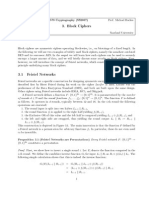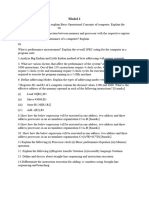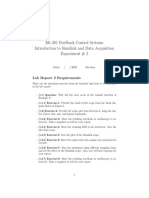C++ AMP Errata: Chapter 1: Vectorization (Page 8)
C++ AMP Errata: Chapter 1: Vectorization (Page 8)
Uploaded by
dr_s_m_afzali8662Copyright:
Available Formats
C++ AMP Errata: Chapter 1: Vectorization (Page 8)
C++ AMP Errata: Chapter 1: Vectorization (Page 8)
Uploaded by
dr_s_m_afzali8662Original Title
Copyright
Available Formats
Share this document
Did you find this document useful?
Is this content inappropriate?
Copyright:
Available Formats
C++ AMP Errata: Chapter 1: Vectorization (Page 8)
C++ AMP Errata: Chapter 1: Vectorization (Page 8)
Uploaded by
dr_s_m_afzali8662Copyright:
Available Formats
C++ AMP Errata
The following is a list of the errata for the book. If you find other errors with the book text then please
report them on the O'Reilly Errata page. For issues related to the code samples please file an issue on
Codeplex.
Chapter 1: Vectorization (page 8)
The code fragment should read as follows. Note the use of the & operator rather than &&.
int CPUInfo[4] = { -1 };
__cpuid(CPUInfo, 1);
bool bSSEInstructions = (CpuInfo[3] >> 24 & 0x1);
Chapter 1: OpenMP (page 10)
There is a small technical mistake here. The text should state that the loop is not parallelizable in its
current form. This loop is parallelizable but must be rewritten to remove the loop carried dependency.
The developer is responsible for writing a loop that is parallelizable, of course, and this is the truly hard part of
the job. For example, this loop is not parallelizable in its current form:
for (int i = 1; i <= n; ++i)
a[i] = a[i - 1] + b[i];
Chapter 2: The CPU NBody Classes (page 36)
The code fragment should read as follows. Note the use of the += operator add the current particle's
acceleration to acc, rather than using the = operator to set the value.
std::for_each(pParticlesIn, pParticlesIn + numParticles, [=, &acc](const ParticleCpu& p)
{
const float_3 r = p.pos - pos;
float distSqr = SqrLength(r) + m_softeningSquared;
float invDist = 1.0f / sqrt(distSqr);
float invDistCube = invDist * invDist * invDist;
float s = m_particleMass * invDistCube;
acc += r * s;
});
Chapter 3: array_view<T,N> (page 52)
The code fragment should read as follows. The reference to av.grid has been replaced with av.extent.
The grid property was the name used for extent in the beta release of C++ AMP.
std::vector<int> v(5);
std::iota(v.begin(), v.end(), 0);
array_view<int, 1> av(5,v);
parallel_for_each(av.extent, [=](index<1> idx) restrict(amp)
{
av(idx) = av(idx) * 2;
});
av.synchronize();
Page 1 29 November 2012
Chapter 4: Tile Barriers and Synchronization (page 74)
The references to variable TS should refer to TileSize. The code fragment should read as follows.
for (int i = 0; i < W; i += TileSize)
{
tile_static float sA[TileSize][TileSize];
tile_static float sB[TileSize][TileSize];
sA[row][col] = a(tidx.global[0], col + i);
sB[row][col] = b(row + i, tidx.global[1]);
for (int k = 0; k < TileSize; k++)
sum += sA[row][k] * sB[k][col];
}
Chapter 7: Efficient Accelerator Global Memory Access (pages 148-9)
This section does not contain any technical mistakes but feedback from readers suggested that it was
not entirely clear. It's been reworded and the second diagram updated to convey the correct meaning.
This difference in execution time is due to the writes to outData being uncoalesced. Although the reads from
inData on each thread are from adjacent memory addresses, the writes to outData from consecutive threads oc-
cur on different rows.
inData outData
1 2 3 4 1 5 9 13
5 6 7 8 2 6 10 14
9 10 11 12 3 7 11 15
13 14 15 16 4 8 12 16
This explains the big difference in performance. The threads (numbered in the diagram above) are writing to
memory locations that are not adjacent. Remember that C++ AMP, like C and C++, stores multi-dimensional data
in row-major order, so the shaded row represents coalesced memory access while the column in outData is an
uncoalesced access.
It's actually possible to use tile static memory to mitigate this by adding an additional set of copies, as shown
in the following example:
... Code sample is unchanged. See the original text.
Here the kernel is divided into two phases using the familiar tiled kernel pattern introduced in Chapter 4. In the
first part of the kernel each thread in the tile copies coalesced data from inData in global memory into tile static
localData and transposes it during the copy to tile static memory. After the barrier—which ensures that all threads
have finished the copy—the data is written in a coalesced way back to global memory. Tile static memory has a
much higher bandwidth and smaller interface width than global memory, so the penalty for uncoalesced memory
accesses is far less. By transferring the matrix elements by means of tile static memory and doing the transpose
there, uncoalesced writes to global memory can be eliminated. The diagram shows four tiles (numbered in bold),
each with four threads. The memory accesses for the threads in tile 2 are shown shaded. It clearly shows that the
writes to outData by threads 1 and two in tile 2 are now coalesced.
Page 2 29 November 2012
inData localData outData
11 2 21 2 21 3 11 2 31 2
3 4 3 4 2 4 3 4 3 4
31 2 41 2 21 2 41 2
3 4 3 4 21 2 3 4 3 4
3 4
Chapter 12: Additional C++ AMP Features on Windows 8 (page 295)
This section did not contain any mistakes at the time of writing.
Since publication of the book Microsoft has released the Platform Update for Windows 7. This update enables
both debugger support and the WARP accelerator on Windows 7 and Windows Server 2008 R2. The following
blog posts detail how these features are now enabled.
C++ AMP CPU fallback support now available on Windows 7
C++ AMP GPU debugging now available on Windows 7
Page 3 29 November 2012
You might also like
- React 18Document63 pagesReact 18Sai YashwanthNo ratings yet
- MidtermDocument5 pagesMidtermkhaledmosharrafmukutNo ratings yet
- Rocket Simulation With Matlab CodeDocument12 pagesRocket Simulation With Matlab Codegaza001No ratings yet
- 985725Document21 pages985725Hari XcelNo ratings yet
- iOS Development GuideDocument104 pagesiOS Development GuideEnrique Fernández100% (1)
- GPU Programming EE 4702-1 Final Examination: Exam TotalDocument10 pagesGPU Programming EE 4702-1 Final Examination: Exam TotalmoienNo ratings yet
- Aca305 2000Document8 pagesAca305 2000Vanitha VivekNo ratings yet
- 09 ParallelizationRecap PDFDocument62 pages09 ParallelizationRecap PDFgiordano manciniNo ratings yet
- ECE408 2012 Practice Exam1Document10 pagesECE408 2012 Practice Exam1shahdabdelrhman8xNo ratings yet
- Basic Parallel Computing (10 Points)Document5 pagesBasic Parallel Computing (10 Points)john carmackNo ratings yet
- FinalDocument4 pagesFinalApinya SUTHISOPHAARPORNNo ratings yet
- 1157_CS_F425_20231222015056_Mid_Semester_Question_Paper_DLDocument2 pages1157_CS_F425_20231222015056_Mid_Semester_Question_Paper_DLMahesh KadapaNo ratings yet
- Operating System Assignment - II2023-24 - IT B V SEMESTERDocument11 pagesOperating System Assignment - II2023-24 - IT B V SEMESTERRajarapu ChaitanyaNo ratings yet
- Dsebl ZG522Document4 pagesDsebl ZG522Raju DNANo ratings yet
- Lab 2Document8 pagesLab 2SAURABH DEGDAWALANo ratings yet
- Feistel ProofDocument15 pagesFeistel ProofmaxigisNo ratings yet
- Commands of PDDocument18 pagesCommands of PDRA NDYNo ratings yet
- Operating Systems (CS422) : Name: NetidDocument5 pagesOperating Systems (CS422) : Name: NetidnarendraNo ratings yet
- Second Examination: Name: Netid: Lab Section (Day/Time)Document14 pagesSecond Examination: Name: Netid: Lab Section (Day/Time)sandbox7117No ratings yet
- Matlab File - Deepak - Yadav - Bca - 4TH - Sem - A50504819015Document59 pagesMatlab File - Deepak - Yadav - Bca - 4TH - Sem - A50504819015its me Deepak yadavNo ratings yet
- OS 5th ETC M 14Document3 pagesOS 5th ETC M 14Ishwari devi ChandrakarNo ratings yet
- Knitr ManualDocument11 pagesKnitr ManualRobin C DSNo ratings yet
- Exam2b s11Document13 pagesExam2b s11serhatandic42No ratings yet
- Un Coalesced Global AccessesDocument14 pagesUn Coalesced Global AccessesPhilippe JeannotNo ratings yet
- Indian Institute of Technology, Kharagpur: Mid-Spring Semester 2021-22Document4 pagesIndian Institute of Technology, Kharagpur: Mid-Spring Semester 2021-22Utkarsh PatelNo ratings yet
- Uncoalesced Global AccessesDocument14 pagesUncoalesced Global AccessesonementalistNo ratings yet
- MCS-012 byDocument111 pagesMCS-012 by7urif7udr1No ratings yet
- Gate Sample PaperDocument7 pagesGate Sample Papershettyashwin19No ratings yet
- Double Ended Queue: Dept of Cse, Brce 1Document28 pagesDouble Ended Queue: Dept of Cse, Brce 1VISHAL KOULNo ratings yet
- Caffa3d MBDocument16 pagesCaffa3d MBJeremy Dudley100% (1)
- Implementing A Custom X86 EncoderDocument25 pagesImplementing A Custom X86 EncoderazpoeiNo ratings yet
- CN Lab ManualDocument51 pagesCN Lab ManualA Sai NikhithNo ratings yet
- DB2 Program PreperationDocument6 pagesDB2 Program PreperationSudheer.rbNo ratings yet
- Knitr ManualDocument11 pagesKnitr ManualNonameNo ratings yet
- Quiz For Chapter 7 With SolutionsDocument8 pagesQuiz For Chapter 7 With SolutionsThịi ÁnhhNo ratings yet
- Spark 3.0 New Features: Spark With GPU SupportDocument8 pagesSpark 3.0 New Features: Spark With GPU SupportMohammed HusseinNo ratings yet
- Inf2c Cs 201314Document10 pagesInf2c Cs 201314davidcorreobasura1No ratings yet
- Computer Science 37 HW 2Document5 pagesComputer Science 37 HW 2Alexander TaylorNo ratings yet
- Kien-Truc-May-Tinh - David-Brooks - cs146-hw2 - (Cuuduongthancong - Com)Document5 pagesKien-Truc-May-Tinh - David-Brooks - cs146-hw2 - (Cuuduongthancong - Com)Ann HerbstNo ratings yet
- Co ImpDocument7 pagesCo ImpG09Deviprasad N shettyNo ratings yet
- PL01 GuiaoDocument3 pagesPL01 GuiaoJoão LourençoNo ratings yet
- Dspworkshop Part2 2006Document48 pagesDspworkshop Part2 2006Naagaraaju AaraadhyulaNo ratings yet
- Int and Float and Print FormatingDocument6 pagesInt and Float and Print FormatingObi InwelegbuNo ratings yet
- The Kenya Polytechnic University CollegeDocument4 pagesThe Kenya Polytechnic University CollegeNaftali CheropNo ratings yet
- Operating SystemsDocument41 pagesOperating Systemstushu_hearthackerNo ratings yet
- C SolutionDocument8 pagesC SolutionGobara DhanNo ratings yet
- GATE QnADocument5 pagesGATE QnAGaurav MoreNo ratings yet
- Training 3Document17 pagesTraining 3Thomas George100% (1)
- Lab 1 Intro To High Performance ComputingDocument8 pagesLab 1 Intro To High Performance ComputingPhil JonesNo ratings yet
- Tips and Tricks of CATIADocument5 pagesTips and Tricks of CATIAjohnsantoshfNo ratings yet
- Computer Organization and Assembly Language: Laboratory ManualDocument25 pagesComputer Organization and Assembly Language: Laboratory ManualMohd ShahNo ratings yet
- An Attempt To Illustrate Differences Between Memory Ordering and Atomic AccessDocument15 pagesAn Attempt To Illustrate Differences Between Memory Ordering and Atomic AccessArvind DevarajNo ratings yet
- EE-361 Feedback Control Systems Introduction To Simulink and Data Acquisition Experiment # 2Document23 pagesEE-361 Feedback Control Systems Introduction To Simulink and Data Acquisition Experiment # 2Shiza ShakeelNo ratings yet
- hệ điều hànhDocument18 pageshệ điều hànhfranklampardnumber8No ratings yet
- Sap Sybase Replication Server Internals and Performance TuningDocument36 pagesSap Sybase Replication Server Internals and Performance Tuningprasadn66No ratings yet
- Exam2 s09 v2Document10 pagesExam2 s09 v2serhatandic42No ratings yet
- SIEMENS Technical Paper 2Document18 pagesSIEMENS Technical Paper 2Saniya Shaikh100% (1)
- DD&CO QBANK (Vtu23)Document3 pagesDD&CO QBANK (Vtu23)manjufk456No ratings yet
- Programming Your GPU with OpenMP: Performance Portability for GPUsFrom EverandProgramming Your GPU with OpenMP: Performance Portability for GPUsNo ratings yet
- The Elements of Computing Systems, second edition: Building a Modern Computer from First PrinciplesFrom EverandThe Elements of Computing Systems, second edition: Building a Modern Computer from First PrinciplesNo ratings yet
- Introduction to Computer Organization: An Under the Hood Look at Hardware and x86-64 AssemblyFrom EverandIntroduction to Computer Organization: An Under the Hood Look at Hardware and x86-64 AssemblyNo ratings yet
- C Programming for the Pc the Mac and the Arduino Microcontroller SystemFrom EverandC Programming for the Pc the Mac and the Arduino Microcontroller SystemNo ratings yet
- Geometric Diffusions As A Tool For Harmonic Analysis and Structure Definition of Data: Diffusion MapsDocument6 pagesGeometric Diffusions As A Tool For Harmonic Analysis and Structure Definition of Data: Diffusion Mapsdr_s_m_afzali8662No ratings yet
- Solving PDEs On ManifoldsDocument13 pagesSolving PDEs On Manifoldsdr_s_m_afzali8662No ratings yet
- ! Famous Fluid Equations Are Incomplete (2015) - DoneDocument5 pages! Famous Fluid Equations Are Incomplete (2015) - Donedr_s_m_afzali8662No ratings yet
- Schroedinger vs. N-SDocument14 pagesSchroedinger vs. N-Sdr_s_m_afzali8662No ratings yet
- ! A Fluid New Path in Grand Math Challenge (2014) - DoneDocument4 pages! A Fluid New Path in Grand Math Challenge (2014) - Donedr_s_m_afzali8662No ratings yet
- Risk Management Reference Materials PDFDocument1 pageRisk Management Reference Materials PDFdr_s_m_afzali8662No ratings yet
- Technical Description of The D-Wave Quantum Processing Unit: User ManualDocument56 pagesTechnical Description of The D-Wave Quantum Processing Unit: User Manualdr_s_m_afzali8662No ratings yet
- Measuring Computation Time On D-Wave Systems: User ManualDocument22 pagesMeasuring Computation Time On D-Wave Systems: User Manualdr_s_m_afzali8662No ratings yet
- KDV EquationDocument4 pagesKDV Equationdr_s_m_afzali8662No ratings yet
- Underlying Physical Principles (Feb 8 - Feb 13) : - Lagrangian and Eulerian - Physical InvarianceDocument16 pagesUnderlying Physical Principles (Feb 8 - Feb 13) : - Lagrangian and Eulerian - Physical Invariancedr_s_m_afzali8662No ratings yet
- What Percentage of The Earth Is Covered by Viscous Fluid?Document30 pagesWhat Percentage of The Earth Is Covered by Viscous Fluid?dr_s_m_afzali8662No ratings yet
- Biology and Mechanics of Blood FlowDocument672 pagesBiology and Mechanics of Blood Flowdr_s_m_afzali8662100% (3)
- Modelling of High-Pressure Dense Diesel Sprays With Adaptive Local Grid RefinementDocument22 pagesModelling of High-Pressure Dense Diesel Sprays With Adaptive Local Grid Refinementdr_s_m_afzali8662No ratings yet
- Spatial Droplets Size Distribution in A Diesel Spray Taken by Photography With Super High ResolutionDocument6 pagesSpatial Droplets Size Distribution in A Diesel Spray Taken by Photography With Super High Resolutiondr_s_m_afzali8662No ratings yet
- Combustion Performance Test of A New Fuel DME To Adapt To A Gas Turbine For Power GenerationDocument6 pagesCombustion Performance Test of A New Fuel DME To Adapt To A Gas Turbine For Power Generationdr_s_m_afzali8662No ratings yet
- Presentation - Unit No.7 - Lesson No.1-2 - Grade 10Document25 pagesPresentation - Unit No.7 - Lesson No.1-2 - Grade 10Rub BingNo ratings yet
- UnixDocument12 pagesUnixsophia khanNo ratings yet
- PHP JSON FunctionsDocument3 pagesPHP JSON FunctionsThant ThantNo ratings yet
- FPL Unit II NotesDocument12 pagesFPL Unit II Notesihavecrush55No ratings yet
- Fp301 Object Oriented ProgrammingDocument6 pagesFp301 Object Oriented ProgrammingNurul Hidayah AzmiNo ratings yet
- Python For Data Science, AI & Development - IBM - Course Info - CourseraDocument1 pagePython For Data Science, AI & Development - IBM - Course Info - CourseraMNo ratings yet
- Fundamentals of Software Engineering: Prof. Dr. Ing. Moldoveanu AlinDocument24 pagesFundamentals of Software Engineering: Prof. Dr. Ing. Moldoveanu AlinRobinson-Constantin CheraNo ratings yet
- V - CSE - CCS375 - WT - QB - Unit1 (5 Files Merged)Document31 pagesV - CSE - CCS375 - WT - QB - Unit1 (5 Files Merged)vinodhaNo ratings yet
- CS8392 - Oop - Unit - 2 - PPT - 2 .1Document20 pagesCS8392 - Oop - Unit - 2 - PPT - 2 .1Vasantha Kumar .V100% (1)
- Chapter 9Document22 pagesChapter 9Adarsh SahNo ratings yet
- MKSDCDocument27 pagesMKSDCbabloo08No ratings yet
- CL-217 Object Oriented Programming Lab # 3Document3 pagesCL-217 Object Oriented Programming Lab # 3Abubaker MehboobNo ratings yet
- Oracle® Developer SuiteDocument98 pagesOracle® Developer SuiteStock CellNo ratings yet
- Hammerdb CommandlineDocument2 pagesHammerdb Commandlineabc6309982No ratings yet
- Flight Management SystemDocument10 pagesFlight Management SystemVaishnav BhorNo ratings yet
- Python and Data Analytics in Oil and GasDocument43 pagesPython and Data Analytics in Oil and Gasdheerendra07100% (2)
- Asm2 Java ProgrammingDocument14 pagesAsm2 Java ProgrammingHưng LêNo ratings yet
- Wolaita Sodo University School of Informatics Department of Information SystemsDocument165 pagesWolaita Sodo University School of Informatics Department of Information SystemsAni Nimoona DhaNo ratings yet
- Adobe Incopy CC 2018 Scripting ReadmeDocument4 pagesAdobe Incopy CC 2018 Scripting ReadmeYusepeNo ratings yet
- Self Balancing Binary Search TreeDocument4 pagesSelf Balancing Binary Search Treethe_swagmasterNo ratings yet
- Problem Solving Using PythonDocument17 pagesProblem Solving Using Pythonisidro ylananNo ratings yet
- Pe 2 Ipt (F2022)Document13 pagesPe 2 Ipt (F2022)Akmal AzharNo ratings yet
- Flask-Socketio Documentation: Miguel GrinbergDocument43 pagesFlask-Socketio Documentation: Miguel GrinbergEmmanuel MuswaloNo ratings yet
- Microsoft Enterprise Library 5.0 Migration GuideDocument11 pagesMicrosoft Enterprise Library 5.0 Migration GuideLagui GrisalesNo ratings yet
- IECV2 - CFSV2 (1) (1) .0 - MT2 - V2.0.mdb (3) Send by AjayDocument28 pagesIECV2 - CFSV2 (1) (1) .0 - MT2 - V2.0.mdb (3) Send by AjayajaybahoriyakumarNo ratings yet
- Vipul Nikam IIT DharwadDocument1 pageVipul Nikam IIT Dharwadrohitgaikwad01012000No ratings yet
- 2018 A2 U3 QP (Eduqas)Document7 pages2018 A2 U3 QP (Eduqas)Wyatt CtNo ratings yet








































































































